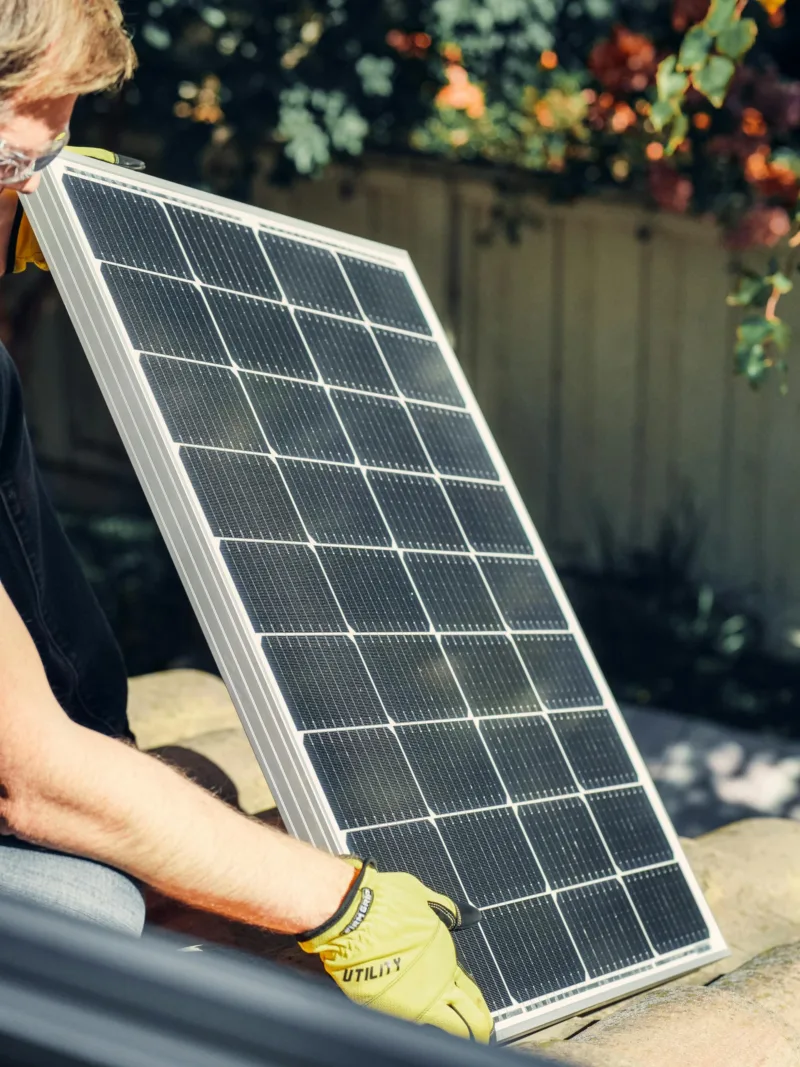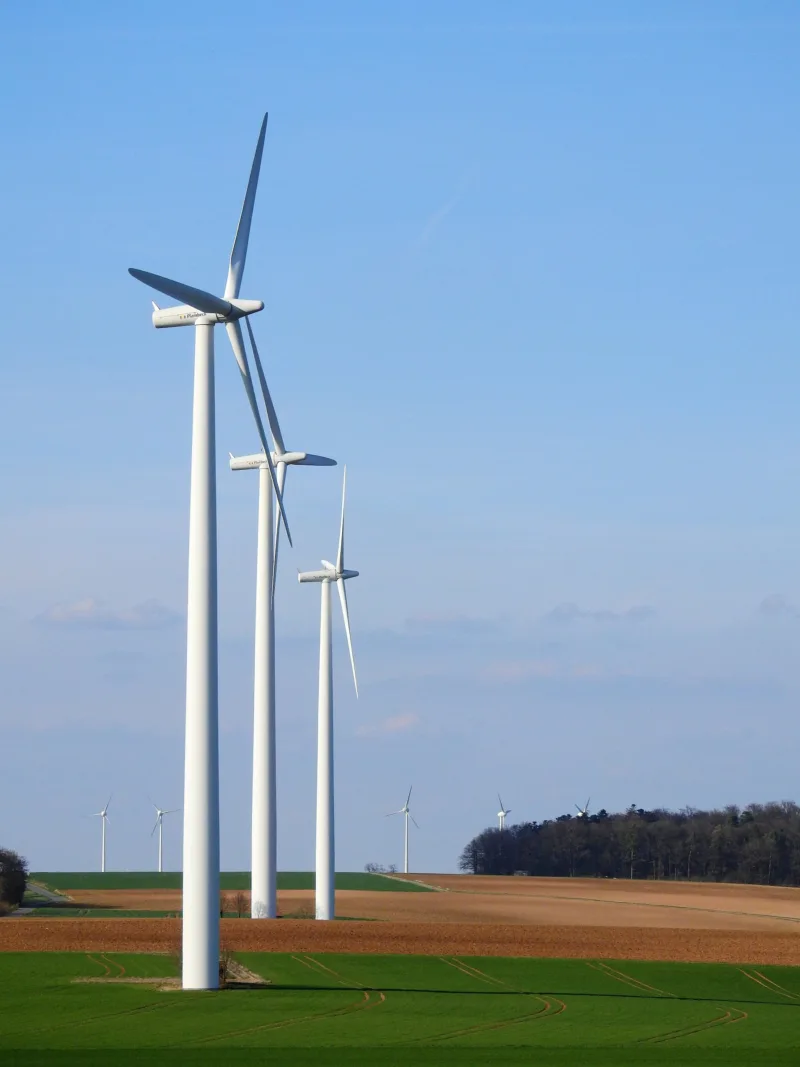Table of Contents Show
Introduction
The renewable energy industry has been making waves in recent years, and for good reason. With the escalating threat of climate change, the significance of renewable energy cannot be overstated. This green sector holds the key to curbing greenhouse gas emissions and paving the way towards a sustainable future.
This guide aims to shine a light on three crucial elements that are driving the renewable energy revolution: solar power advancements, wind energy technologies, and sustainable energy storage systems. These fields are not static; they evolve at a rapid pace, fueled by continuous innovation.
Solar Power Advancements
Solar power has come a long way from its humble beginnings, with forward leaps in solar cell design and battery capacity. These changes have enabled solar technology to be more efficient, cost-effective, and versatile than ever before.
Wind Energy Technologies
As for wind energy technologies, we’re seeing taller wind turbines and offshore installations that can harness stronger winds—maximizing the potential of this renewable resource.
Sustainable Energy Storage Systems
Last but not least, sustainable energy storage systems play a pivotal role in integrating renewables into our power grids. Advancements in this area allow us to store surplus power generated by solar or wind and use it when needed.
Innovation is the lifeblood of these sectors. The renewable industry’s progress to date is remarkable—but there’s still more work to be done. We need to keep pushing boundaries, exploring new ideas, and refining current technologies to ensure a clean, reliable energy future for all.
1. Advancements in Solar Power
The realm of solar technology is brimming with innovations, all aimed at harnessing the sun’s power more efficiently and cost-effectively. One area that has seen significant progress is the design of solar cells.
Longer-lasting Solar Cells
Longer-lasting solar cells are making a big splash in the industry. The lifespan of solar panels used to hover around 25 years, but newer designs are pushing past this limitation. Scientists and engineers are developing advanced solar cells that can withstand the harsh effects of weather and time, ensuring you get the most out of your investment.
Printed Solar Cells
Another exciting development in solar cell design is the advent of printed solar cells. Imagine being able to print solar cells onto various surfaces just like you would print an image or text on paper. This isn’t a far-off dream, but a reality that’s steadily unfolding. Printed solar cells offer a low-cost, flexible solution for integrating solar power into everyday objects – from buildings to vehicles and even clothing! With these advancements, it’s clear to see why many believe we’re on the cusp of a new era in photovoltaic technology.
Increased Capacity of Solar Batteries
Solar batteries have also been subject to innovative strides. The increased capacity of solar batteries is a key enabler for better energy storage. More capacity means being able to store more power during periods of peak sunlight for use when it’s cloudy or dark. This not only makes solar power more reliable but also increases its potential as a primary source of electricity.
Use of New Materials
No discussion about advancements in solar technology would be complete without mentioning the use of new materials. Traditional silicon-based solar cells have served us well over the years, but newer alternatives promise even greater efficiency. One such material is perovskite, a mineral that can absorb light across all visible wavelengths. Its excellent light-harvesting properties combined with low production costs make it an attractive option for future photovoltaic devices.
In the field of solar power advancements, these are some of the recent highlights:
- Longer-lasting solar cells that promise durability and longevity
- Printed solar cells that provide flexibility in application
- Increased capacity of solar batteries for optimal energy storage
- Use of new materials like perovskite to enhance efficiency
These developments are transforming the way we harness and use solar energy, moving us closer to a sustainable future powered by the sun. With continuous advancements in technology, it’s safe to say that solar power will play an even more significant role in our energy mix.
2. Advancements in Wind Energy Technologies
Harnessing the power of the wind is not a new concept, but recent advancements in wind energy technologies have propelled us toward a cleaner energy future. These advancements include:
The Role of Wind Energy in the Renewable Mix
Wind energy stands as a cornerstone in the renewable energy landscape, seamlessly complementing solar power. It thrives during periods when solar panels may fall short, such as at night or during overcast days. Here’s how wind energy slots into our green energy mix:
- Peak Demand Alignment: Wind patterns often align well with electricity demand, picking up speed in the late afternoon and evening.
- Geographical Diversity: Different regions can harness wind at varying times and intensities, balancing out energy availability.
- Cost-Effectiveness: As technology has matured, the cost of wind-generated electricity has significantly dropped, making it one of the most competitive renewable options.
Breakthroughs in Wind Turbine Technology
Innovation within wind turbine technology has been nothing short of revolutionary. Let’s delve into these breakthroughs:
Taller Towers
By reaching new heights, taller towers access steadier and faster winds above ground level, thereby increasing potential energy output. These lofty structures enable turbines to capture a more consistent flow of wind, translating to a more reliable supply of electricity.
Blade Length
Longer blades have a larger sweep area to catch wind, enhancing the capacity to generate power even at low wind speeds. This design improvement means turbines can operate efficiently across a wider range of conditions.
Offshore Installations
Offshore wind farms exploit powerful marine breezes and face fewer logistical constraints than their land-based counterparts. By situating turbines at sea:
- Stronger Winds: They tap into coastal winds that are typically stronger and more dependable.
- Visual Impact: The visual impact on landscapes is minimized.
- Spatial Freedom: Large-scale projects can be realized without land-use conflicts.
Integration with the Grid
Effective integration with power grids is paramount for leveraging renewable energy sources to their fullest potential. Here’s why:
- Stabilizing Supply: Advanced grid management helps mitigate variability in wind energy supply.
- Energy Distribution: Efficient transmission systems distribute generated power from remote or offshore locations to where it’s needed most.
- Smart Technology: The incorporation of smart technology enables predictive analysis for optimizing turbine performance based on weather forecasts.
These advancements in wind energy technologies promise an even more integral role in our sustainable future. With each technological leap—from ground-breaking designs that push turbines higher into the sky to sophisticated offshore installations—wind power becomes more entrenched in our renewable portfolio.
The ingenuity fueling these advancements ensures that every gust translates into clean electricity for homes, businesses, and industry alike. As we press on in our journey toward sustainability, understanding and embracing these innovations is key to unlocking the full potential of renewable resources like wind.
3. Sustainable Energy Storage Systems
Sustainable energy storage systems are the linchpin in the machinery of renewable energy, allowing us to harness and hold onto the intermittent power provided by sources like the sun and wind. As these natural resources don’t deliver a constant stream of energy, storing what they generate for later use is critical for a consistent supply.
The Pivotal Role of Energy Storage
Energy storage systems step into the spotlight when it comes to managing the ebbs and flows of renewable energy production. With their ability to stockpile excess electricity during peak production times, these systems ensure that power is available when demand is high and generation is low.
Types of Sustainable Energy Storage Systems
Here are some common types of sustainable energy storage systems:
- Battery Storage: Among the array of storage options, battery storage stands out for its adaptability. It can be scaled from small home systems to large utility-scale projects, making it an attractive option for a wide range of applications.
- Pumped Hydro: This established method uses excess electricity to pump water uphill to a reservoir. When power is needed, water is released back downhill through turbines, generating electricity on demand.
- Flywheel Energy Storage: Here, kinetic energy is stored in a rotating mass and can be quickly released when needed, offering a valuable tool for balancing short-term power fluctuations.
Battery Energy Storage Systems (BESS)
Digging deeper into battery storage reveals why Battery Energy Storage Systems (BESS) have become such a cornerstone in sustainable energy strategies:
- Integration Capabilities: BESS seamlessly integrates with renewable sources, smoothing out the supply by releasing stored energy during periods of low generation or high demand.
- Versatility in Use: They are incredibly versatile, providing services such as peak shaving, load leveling, and emergency backup.
- Technological Advancements: Innovations are continuously improving their efficiency and lifespan while driving down costs.
Types of Batteries Used in BESS
Different types of batteries offer unique benefits within BESS:
- Lithium-Ion: Popular for their high energy density and long life cycle; ideal for both residential and larger scale applications.
- Lead-Acid: Known for its reliability and cost-effectiveness; typically used in less demanding installations.
- Flow Batteries: Offer longer durations of energy discharge, which can be beneficial for grid stabilization over extended periods.
Integration with Renewable Sources
The integration of BESS with renewable sources like solar and wind merits particular attention. BESS acts as a buffer that absorbs surplus generation and feeds it back into the grid or direct use when needed. This symbiosis enhances the overall efficiency of renewable energy systems by matching supply with demand more closely.
Advantages Of Traditional Power Plants
Compared to traditional power plants that may take considerable time to ramp up or down, BESS can respond almost instantaneously to changes in demand or supply. This rapid response capability is crucial in maintaining grid stability as we rely more on variable renewable energy sources.
The Broader Implications
Considering the broader implications of sustainable energy storage:
- By enabling more renewables on the grid, storage systems reduce reliance on fossil fuels and help cut greenhouse gas emissions.
- The resilience of the power grid increases with distributed storage capacity that can provide localized support during outages or disasters.
- Economically, as storage technologies advance and become more cost-effective, they pave the way for new business models and investment opportunities within the clean energy sector.
Transitioning Seamlessly
As we transition away from fossil fuels towards cleaner alternatives, integrating sustainable energy storage into our existing infrastructure becomes increasingly paramount.
4. The Future of Renewable Energy
The horizon for renewable energy is bright and burgeoning, with solar power and wind energy technologies at the forefront. These advancements are paving the way for a transformative clean energy transition, marking a significant shift towards a sustainable future.
Renewable Energy Future
– Solar Power and Wind Energy Advancements:
The leaps made in solar cell longevity and efficiency, alongside innovative wind turbine designs, are setting the stage for an era where renewables may dominate the energy landscape.
– Efficient Utilization of Resources:
Sustainable energy storage systems stand as pivotal enablers, ensuring that the intermittent nature of solar and wind power does not hinder their effectiveness in meeting our escalating energy needs.
Policy Support: A Catalyst for Change
Without a doubt, policy support emerges as a linchpin in fostering a robust renewable energy sector. Legislation and government backing provide the necessary impetus for:
- Driving Investment: Policies that encourage financial inflows into renewable projects can reduce costs and speed up the development of new technologies.
- Spurring Innovation: With adequate policy measures, companies are incentivized to push the envelope in technology, resulting in breakthroughs that can revolutionize how we harness and store renewable energy.
- Ensuring Smooth Transition: Government policies need to strike a delicate balance between advancing renewables and maintaining grid stability to facilitate a seamless shift from traditional fuels.
Investment in Research and Development
The commitment to research and development holds immense potential to catalyze further progress within the renewable energy sector.
- Cutting-Edge Technologies: Continuous investment in R&D could unveil next-generation solar cells, more resilient wind turbines, or revolutionary storage solutions.
- Enhanced Performance: With ongoing R&D efforts, future technologies may deliver unparalleled efficiencies at significantly reduced costs.
Beyond Solar and Wind
While solar and wind power grab the headlines, let’s also shine a light on other clean sources that contribute to diversifying our renewable portfolio:
- Hydropower: This time-tested source continues to be optimized through innovations in turbine technology and low-impact environmental design.
- Geothermal Energy: As an always-on resource, geothermal holds promise, especially with advancements that could unlock its potential even in less active areas.
As we delve deeper into this narrative of renewable energies shaping our future, it’s evident that each piece of the puzzle – from technological innovation to policy frameworks – must fit together seamlessly. It’s this synergy that will drive us towards not just envisioning but actualizing a fully sustainable energy ecosystem.
Also Read:
Advancing Towards a Sustainable Future
As we move towards a future powered by renewable energy, opportunities abound in the field of renewable energy engineering. From the design and implementation of solar power systems and wind energy technologies to the development of innovative energy storage solutions, there’s a wide spectrum of career paths that allow professionals to make significant contributions towards sustainable energy solutions.
Exciting Career Opportunities in Renewable Energy Engineering
For those with an inclination towards technical innovation and a passion for environmental sustainability, renewable energy engineering careers are replete with exciting opportunities. These roles offer the chance to:
- Develop innovative solar power technologies for improved efficiency and cost-effectiveness.
- Design advanced wind turbines capable of harnessing stronger winds for greater electricity generation.
- Work on cutting-edge energy storage systems that enable more efficient utilization of renewable sources.
In addition to being professionally rewarding, these careers offer the satisfaction of contributing directly to the fight against climate change and the move towards a cleaner, sustainable future.
The Growing Renewable Energy Market
As the world grows increasingly aware of the need to curb carbon emissions, the renewable energy market is expanding rapidly. This growth is not only driving innovation in technology but also creating new job opportunities in the sector. This vibrant market presents a multitude of opportunities for investment and innovation across solar power, wind energy, and energy storage technologies.
A key driver for this growth is economies of scale. As larger volumes of renewable technologies are produced and deployed, costs are driven down, making renewable energy even more attractive as an investment. In fact:
A robust renewable energy market incentivizes investments, reduces costs through economies of scale, and accelerates our progress towards a sustainable future.
The Importance of Renewable Energy Infrastructure
However, to truly leverage these advancements in renewable technologies, we must also focus on developing resilient renewable energy infrastructure. This infrastructure is crucial to ensure a reliable and sustainable power system that can effectively integrate varying sources of renewable energy while meeting our growing electricity demand.
Investment in renewable infrastructure extends beyond the immediate economic benefits. It also contributes to:
- Mitigating climate change by reducing reliance on fossil fuels.
- Enhancing energy security by diversifying energy sources.
- Creating employment opportunities in construction, operations, and maintenance.
Embracing the Potential of Renewable Energy
So, whether you’re a professional looking to make a difference or an investor eyeing the next big opportunity, the renewable energy sector holds immense potential. It’s time to explore these opportunities and contribute to the ongoing advancements in the field.
In essence, advancing towards a sustainable future is not just about harnessing renewable energy sources. It also involves building a robust market and infrastructure that can support this transition. Together, we can work towards a future where our power systems are not only reliable and efficient but also sustainable for generations to come.
FAQs (Frequently Asked Questions)
The realm of solar technology is brimming with innovations, including longer-lasting solar cells, printed solar cells, increased capacity of solar batteries, and the use of new materials.
Breakthroughs in wind energy technologies include taller towers, longer blades, offshore installations, and effective integration with the grid.
Energy storage systems step into the spotlight when it comes to ensuring a stable and reliable power supply from renewable sources, addressing intermittency issues, and enabling grid flexibility.
Common types of sustainable energy storage systems include battery energy storage systems (BESS) and their integration with renewable sources like solar and wind power.
The future outlook for renewable energy looks promising, with advancements in solar power and wind energy technologies, efficient utilization of resources, policy support as a catalyst for change, investment in research and development, and the growing renewable energy market.
Renewable energy engineering offers exciting career opportunities for professionals looking to make a difference through technical innovation and contribute to the growing renewable energy market.
Citation
- Costa, C. M., Goncalves, R., & Lanceros-Mendez, S. (2023). Sustainable Energy Storage in the Scope of Circular Economy. John Wiley & Sons.
- Jain, V. K., Gomes, C., & Verma, A. (2022). Renewable Energy and Storage Devices for Sustainable Development. Springer Nature.
- Ezema, F. I., Anusuya, M., & Nwanya, A. C. (2023). Materials for Sustainable Energy Storage at the Nanoscale. CRC Press.
- Cheong, K. Y., & Chen, L.-C. (2020). Sustainable Materials for Next Generation Energy Devices. Elsevier.
- The Royal Society. (2022, May 5). Truly sustainable energy storage | The Royal Society [Video]. YouTube. https://www.youtube.com/watch?v=-Sz3ogyeKbk
- CNBC International TV. (2019, June 1). A look at the energy storage solutions | Sustainable Energy [Video]. YouTube. https://www.youtube.com/watch?v=ljKFr_o24jo







